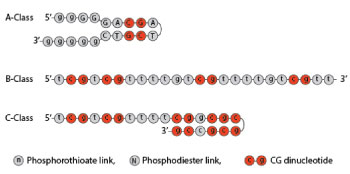Mouse TLR9 Agonist Kit
| Product | Unit size | Cat. code | Docs. | Qty. | Price | |
|---|---|---|---|---|---|---|
|
Mouse TLR9 Agonist Kit Set of known agonists for mouse TLR9 |
Show product |
1 kit |
tlrl-kit9m
|
|
Set of known agonists for mouse TLR9
This kit contains archetypal CpG ODNs of the A-, B- or C-class described for mice cells immunostimulation via TLR9.
Choose the most suitable class of ODN for your studies, from:
![]() Read our review about TLR9 agonists.
Read our review about TLR9 agonists.
Back to the top
Specifications
Specificity: Murine TLR9 agonists
Quality control:
- TLR9 activity has been tested using HEK-Blue™ TLR9 cells.
- The absence of bacterial contamination (e.g. lipoproteins and endotoxins) has been confirmed using HEK-Blue™ TLR2 and HEK-Blue™ TLR4 cells.
Sequences:
ODN 1585 (class A): 5’- ggGGTCAACGTTGAgggggg -3’ (20 mer)
ODN 1585 Control: 5’- ggGGTCAAGCTTGAgggggg-3'' (20 mer)
ODN 1826 (class B): 5’- tccatgacgttcctgacgtt-3’ (20 mer)
ODN 1826 Control: 5’- tccatgagcttcctgagctt -3’ (20 mer)
ODN2395 (class C): 5’- tcgtcgttttcggcgc:gcgccg-3’ (22 mer)
ODN 2395 Control: 5’- tgctgcttttggggggcccccc -3’ (22 mer)
Note: Bases shown in capital letters are phosphodiester, those in lower case are phosphorothioate (nuclease resistant) and palindrome is underlined.
Back to the topContents
ODNs are provided lyophilized:
- 100 μg (15.51 nmol) ODN 1585
- 100 μg (15.51 nmol) ODN 1585 Control
- 100 μg (15.71 nmol) ODN 1826
- 100 μg (15.71 nmol) ODN 1826 Control (ODN 2138)
- 100 μg (14.18 nmol) ODN 2395
- 100 μg (14.18 nmol) ODN 2395 Control
- 1.5 ml endotoxin-free water
![]() Products are shipped at room temperature.
Products are shipped at room temperature.
![]() Products should be stored at -20°C.
Products should be stored at -20°C.
Details
CpG ODNs are synthetic oligonucleotides that contain unmethylated CpG dinucleotides in particular sequence contexts (CpG motifs). These CpG motifs are present at a 20-fold greater frequency in bacterial DNA compared to mammalian DNA [1, 2]. CpG ODNs are recognized by Toll-like receptor 9 (TLR9) leading to strong immunostimulatory effects.
• ODN 1585 is a class A CpG ODN with a preference towards mouse TLR9. Class A CpG ODNs are characterized by a phosphodiester central CpG-containing palindromic motif and a phosphorothioate 3’ poly-G string. They induce high interferon-α (IFN-α) production from plasmacytoid dendritic cells (pDC) but are weak stimulators of TLR9-dependent NF-κB signaling.
• ODN 1585 Control contains GpC dinucleotides instead of CpGs and can be used as a negative control together with ODN 1585.
• ODN 1826 is a class B CpG ODN with a preference towards mouse TLR9. Class B CpG ODNs contain a full phosphorothioate backbone with one or more CpG dinucleotides. They strongly activate B cells but weakly stimulate IFN-α secretion.
• ODN 1826 Control (also known as ODN 2138) contains GpC dinucleotides instead of CpGs and can be used as a negative control together with ODN 1826.
• ODN 2395 is a class C CpG ODN for human and mouse TLR9. Class C CpG ODNs combine features of both classes A and B. They contain a complete phosphorothioate backbone and a CpG-containing palindromic motif. Class C CpG ODNs induce strong IFN-α production from pDC and B cell stimulation.
• ODN 2395 Control contains GpC dinucleotides instead of CpGs and can be used as a negative control with ODN 2395.
1. Krieg A.M. et al., 1995. CpG motifs in bacterial DNA trigger direct B-cell activation. Nature, 374(6522):546-9.
2. Bauer S. et al., 2001. Human TLR9 confers responsiveness to bacterial DNA via species-specific CpG motif recognition. PNAS 98(16):9237-42.





